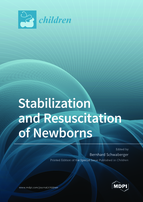Stabilization and Resuscitation of Newborns
A special issue of Children (ISSN 2227-9067). This special issue belongs to the section "Pediatric Neonatology".
Deadline for manuscript submissions: closed (30 September 2021) | Viewed by 61233
Special Issue Editor
Interests: birth asphyxia; preterm birth; initial ventilation strategies; airway management; oxygen titration; timing of umbilical cord clamping; temperature control; chest compressions; neonatal vascular access; emergency medication; post-resuscitation care
Special Issues, Collections and Topics in MDPI journals
Special Issue Information
Dear colleagues,
Annually, approximately 13–26 million newborns worldwide need respiratory support immediately after birth, and another 2–3 million newborns need extensive resuscitation including chest compressions and drug administration. Despite a significant increase in knowledge and enhanced therapy strategies over the past few years, there is still a high incidence of mortality and neurologic morbidity in those patients. Therefore, further research is highly warranted supporting or introducing novel therapies or concepts in the area of the stabilization and resuscitation of preterm and term newborns. Current hot topics in the field include initial ventilation strategies, (difficult) airway management, oxygen titration, the timing of umbilical cord clamping, body temperature control, cardiocirculatory support such as chest compressions, vascular access and emergency medication, and post-resuscitation care. Another crucial topic is neonatal resuscitation education including simulation-based training to improve patient safety and clinical outcomes.
In this Special Issue in Children, we focus on recent aspects of neonatal stabilization and the resuscitation of preterm and term infants. Both reviews and original research will be considered for publication. Senior investigators are welcome to invite mentees and colleagues to co-author submissions under their supervision. We look forward to receiving your contributions!
Dr. Bernhard Schwaberger
Guest Editor
Manuscript Submission Information
Manuscripts should be submitted online at www.mdpi.com by registering and logging in to this website. Once you are registered, click here to go to the submission form. Manuscripts can be submitted until the deadline. All submissions that pass pre-check are peer-reviewed. Accepted papers will be published continuously in the journal (as soon as accepted) and will be listed together on the special issue website. Research articles, review articles as well as short communications are invited. For planned papers, a title and short abstract (about 100 words) can be sent to the Editorial Office for announcement on this website.
Submitted manuscripts should not have been published previously, nor be under consideration for publication elsewhere (except conference proceedings papers). All manuscripts are thoroughly refereed through a single-blind peer-review process. A guide for authors and other relevant information for submission of manuscripts is available on the Instructions for Authors page. Children is an international peer-reviewed open access monthly journal published by MDPI.
Please visit the Instructions for Authors page before submitting a manuscript. The Article Processing Charge (APC) for publication in this open access journal is 2400 CHF (Swiss Francs). Submitted papers should be well formatted and use good English. Authors may use MDPI's English editing service prior to publication or during author revisions.
Keywords
- Birth asphyxia
- Preterm birth
- Initial ventilation strategies
- Airway management
- Oxygen titration
- Timing of umbilical cord clamping
- Temperature control
- Chest compressions
- Vascular access
- Emergency medication
- Post-resuscitation care
- Simulation







